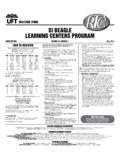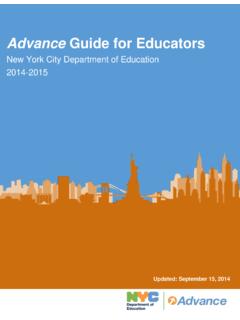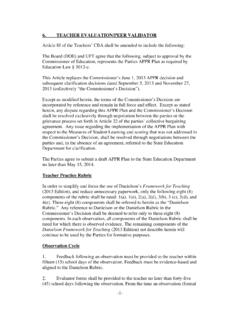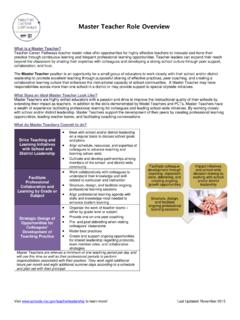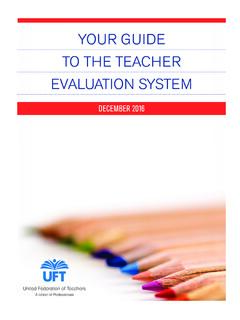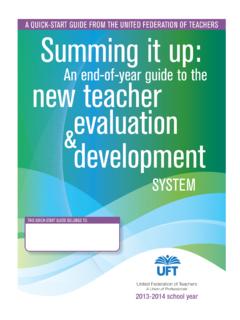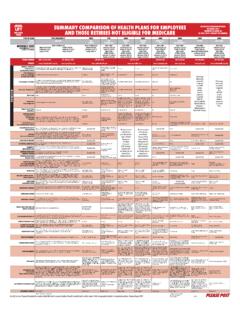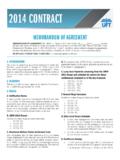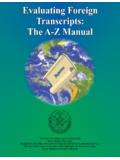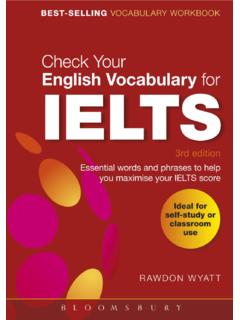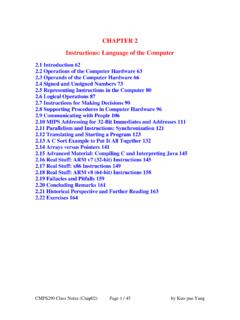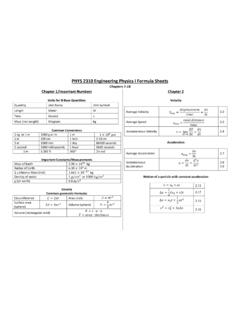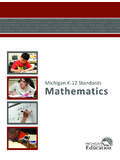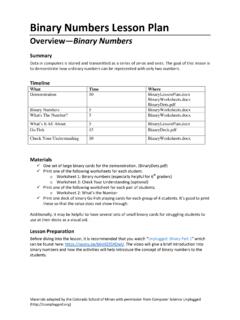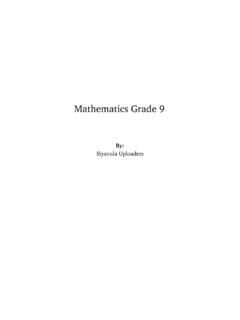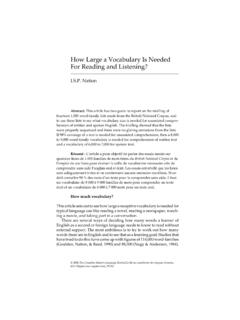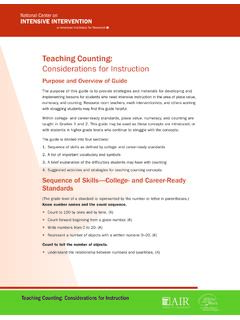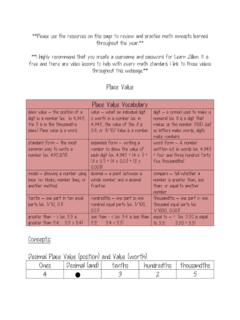Transcription of Priority Learning Standard(s): Mathematics
1 Priority Learning Standard(s): Mathematics How to Use this Information This document identifies the Next Generation Learning standards (NGLS) in Mathematics that have been identified as Priority Learning standard(s). This identification involved the examination of the NGLS in Mathematics by the NYC DOE in collaboration with the UFT and CSA, and was informed by the 2020 21 Priority Instructional Content in English Language Arts/Literacy and Mathematics developed by Student Achievement Partners. This document outlines the areas that have been identified as most important and should help teachers know where to invest their time and efforts as they plan for instruction that addresses unfinished Learning within the context of rich, culturally responsive grade level work. Strong core instruction that is culturally responsive and paired with formative assessment will be the key to teachers pinpointing unfinished Learning and responding in real-time through strategic instruction that offers just in time.
2 Supports, and in the context of grade level standards . To support this type of formative assessment, you will notice this document illustrates the expectations outlined in Priority Learning standard(s) along a progression. Intentional choices were made to break down the language of the standards to reflect the discrete skills that students should know and be able to do at each grade level. For more information about addressing unfinished Learning in the context of grade level Priority Learning standard(s), refer to this overview. Priority Learning for Mathematics : Kindergarten to Grade 2. Priority Core Skills, Knowledge and Understandings Learning Students will . Domain Grade K Grade 1 Grade 2. Counting and Know number names and the count sequence. NY-K-CC 1-3 No Counting and Cardinality identified as Priority for No Counting and Cardinality identified as Priority for Cardinality Count to 100 by ones and by tens; beginning from any Grade 1 Grade 2.
3 Given number Read and write numbers from 0 to 20; Representing a number of objects with a written numeral 0-20. Operations Understand addition as putting together and adding to, Represent and solve problems involving addition and Represent and solve problems involving addition and and and understand subtraction as taking apart and taking subtraction. 1-6 subtraction 1 -2. Algebraic Thinking from. 1-5 Fluently add and subtract within 10 Use their understanding of addition to develop fluency Represent addition and subtraction using objects, Develop strategies for adding and subtracting whole with addition and subtraction within 100 by applying fingers, pennies, drawings, sounds, acting out situations, numbers using a variety of discrete and length based their understanding of models for addition and verbal explanations, expressions, equations, or other models, subtraction Fluently add and subtract within 20 using mental strategies.
4 Fluently add and subtract within 5. Solve word problems Understand connections between counting and addition Using the relationship between addition and subtraction adding and subtracting within 10. and subtraction ( , adding two is the same as Create equivalent but easier or known sums Decompose numbers less than or equal to 10 into pairs counting on two); Know from memory all sums within 20 of two one-digit in more than one way. Use properties of addition to add whole numbers and to numbers. create and use increasingly sophisticated strategies based on these properties ( , making tens ) to solve addition and subtraction problems within 20;. Decomposing a number leading to 0. Using the relationship between addition and subtraction number and Work with number 11-19 to gain foundations for place Understand place value 2-3 Understand place value.
5 2. Operations in value. Develop, discuss, and use efficient, accurate, and Count in fives, tens, and multiples of hundreds, tens, Base Ten Compose and decompose the numbers from 11 to 19 generalizable methods to add within 100 and subtract and ones, as well as number relationships involving into ten ones and one, two, three, four, five, six, seven, multiples of 10 these units, including comparing; and eight, or nine ones Compare whole numbers (at least to 100) to develop Understand multi-digit numbers (up to 1000) written in understanding of and solve problems involving their base-ten notation relative sizes Geometry Identify and describe shapes (squares, circles, triangles, No Geometry standards identified as Priority for Grade 1 No Geometry standards identified as Priority for Grade 2. rectangles, hexagons, cubes, cones, cylinders, and spheres).
6 1-3. Describe objects in the environment using names of shapes, and describe the relative positions of these objects using terms such as above, below, beside, in front of, behind, and next to. Understand the difference between two-dimensional (lying in a plane, flat ) and three dimensional ( solid ). shapes. Measurement Describe and compare measurable attributes 1-2 Measure lengths indirectly and by iterating length units. Relate addition and subtraction to length. 5-6. and Data Describe attributes of an object(s), such as length or 1 Recognize the need for standard units of measure weight, using appropriate vocabulary, and compare two Develop an understanding of the meaning and (centimeter and inch) and use rulers and other objects with a common measurable attribute and processes of measurement, measurement tools with the understanding that linear describe the difference.
7 Measure involves an iteration Recognize that the smaller the unit, the more iterations needed to cover a given length. Classify objects and count the number of objects in each category 3-4. Classify objects into categories; count the objects in each category and sort the categories by count. Explore coins (pennies, nickels, dimes, and quarters). and begin identifying pennies and dimes. K -2 Resources: Achieve the Core Priority Learning NYS Next Generation Mathematics Learning standards Priority Learning for Mathematics : Grades 3 - 5. Priority Core Skills, Knowledge and Understandings Learning : Students will . Domain Grade 3 Grade 4 Grade 5. Operations Represent and solve problems involving multiplication and Use the four operations with whole numbers to solve No Operations and Algebraic Thinking standards identified as and division.
8 Problems. Priority for Grade 5. Algebraic Interpret whole number quotients and products of whole Interpret a multiplication equation as a comparison Thinking numbers Solve multiplication and division situations as Develop an understanding of the meanings of multiplicative comparisons multiplication and division of whole numbers through Use drawings and equations with a symbol for the activities involving equal-sized groups, arrays, and area unknown number models Solve multi-step word problems with whole numbers Understand properties of multiplication and the with whole number answers using four operations relationship between multiplication and division. NY- Solve division problems in which remainders must be interpreted Apply the commutative, associative, and distributive Represent problems using equations or expressions with property of multiplication to multiply and divide a letter standing for the unknown quantity Understand division as an unknown-factor problem Assess reasonableness of answers Multiply and divide within 100.
9 Develop fluency with multiplication and division (fast, accurate, flexible and with understanding) by comparing a variety of solution strategies Know from memory all products of two one-digit numbers Solve problems involving the four operations, and identify and extend patterns in arithmetic. Solve two-step word problems with whole numbers and having whole- number answers using the four operations Represent problems using equations or expressions with a letter representing the unknown quantity Analyze, make sense of situations presented in word problems and persevere in solving them number and No number and Operations in Base Ten standards identified Generalize place value understanding for multi-digit whole Understand the place value system Base Ten as Priority for Grade 3 numbers Recognize that in a multi-digit number , a digit in one Operations Recognize that in a multi-digit whole number .
10 A digit in place represents ten times as much as it represents in one place represents ten times what it represents in the the place to its right and 1/10 of what is represented in place to its right the place to its left. Read, write multi-digit whole numbers using base-ten Read, write, and compare decimals to the thousandths numerals, number names, expanded form using base-ten numerals, number names, and expanded Compare multi-digit numbers based on place value form meanings using >, <, = Use place value understanding to round decimals to any Use place value understanding to round multi-digit whole place numbers to any place Use whole number exponents to denote powers of 10. Explain patterns in the number of zeros of the product when multiplying by powers of 10. Explain patterns in the placement of the decimal point when a decimal is multiplied or divided by a power of 10.

